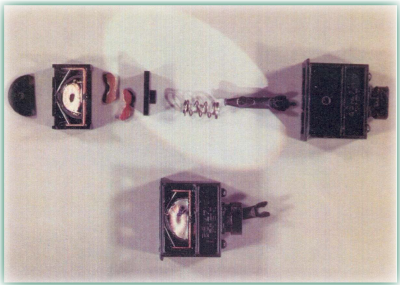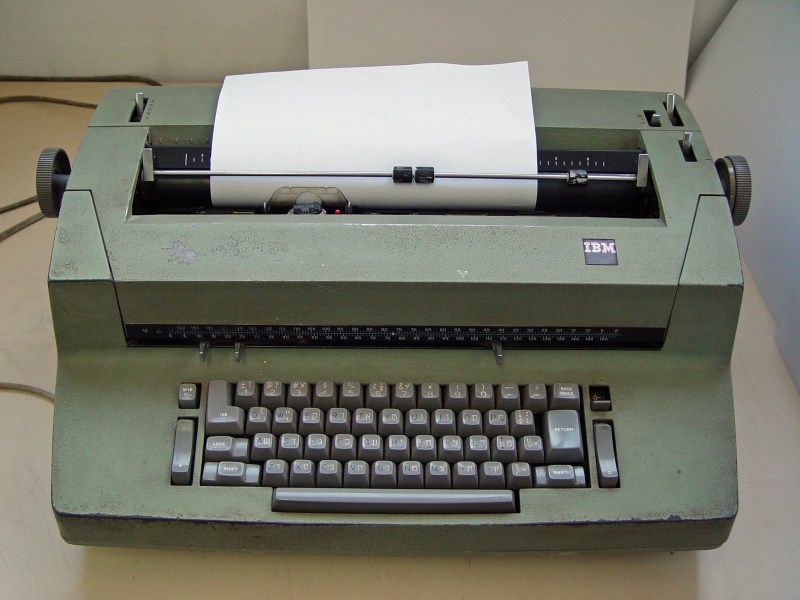As Cold War tensions increased throughout the 1970s, the Soviets pulled out all the stops when it came to digging up information from US diplomats. This NSA memo from 2012 explains how several IBM Selectric typewriters used in the Moscow and Leningrad offices were successfully bugged with electromechanical devices that could possibly have been the world’s first keyloggers.
The Selectric prints with a ball that is spun and tilted to select the desired character. Two mechanical arms control the ball’s spin and tilt, and the keylogger read out the position of those arms. Thus, each character on the Selectric’s type element ball has its own signature. The sensing part of the keylogging mechanism was buried in part of the typewriter chassis, a metal bar that spans the width of the machine, and were so well hidden that they could only have been detected by complete dissassembly or x-ray.

Once the sensors detected a character, it was stored as a digital signal and compressed into four-bit words. When the bug’s buffer reached its eight-word limit, a transmitter in the metal bar sent the characters over RF to Soviet receivers. Despite being invisible to the naked eye, the Soviets wanted more protection from possible detection by frequency analyzer, so the bugs hid the signal by transmitting in the same band as the local television stations.
There wasn’t just one type of keylogger found in these typewriters, either. NSA analysts counted five different varieties. Early models ran on batteries, and later versions pulled AC power from the typewriter itself. And this was their downfall. A technician from the NSA’s COMSEC Standards and Advanced Technology Division grew suspicious upon finding an extra coil in one of the typewriters’ power switches, and the rest is history. Had the Soviets stuck with batteries, these bugs might have gone undetected.
Main image via Wikipedia.
Thanks for the tip, [Itay].
Retrotechtacular is a weekly column featuring hacks, technology, and kitsch from ages of yore. Help keep it fresh by sending in your ideas for future installments.

















I wonder with the available technology, they could have done power channel analysis and bugged the power outlets. With these typewriters I bet you could determine the distance of the rotation and tilt from power draw.
There were bugs around at the time that used a carrier for power.
The people spying transmitted out a signal and listened on another frequency.
It wouldn’t be a huge step to have it transmit key strokes instead of audio.
Where would we be without Tesla (:
It would be helpful if the link to Wikipedia was placed in the title. That way we could go directly to the source material for the article.
Really I agree, this is old hat! What’s with you today HaD?
It’s amazing what lengths people will go to in order to screw over other people. Sheesh.
I grew up during the cold war, and the only accurate information I was ever taught about the Soviet people was by an 8th grade teacher that had visited Russia several times. She said that in Red Square the guards would only let you take pictures from certain angles, and that Russian cigarettes are terrible and you should bring your own if you ever go there. She also said that the people there were just as nice as they are anywhere else in the world, which directly contradicted the ridiculous propaganda that the media had been feeding us about the “monsters” from the USSR.
Eventually I figured out that people are the same everywhere, it’s their governments that are monstrous.
Governments are made up of people. When there is a political conflict, people quickly rally behind their monstrous governments. People are the same everywhere in sharing the same emotions, but their ideologies can differ greatly. People and government are not quite as detached from each other as you imply. People are quick to form clubs, homeowner’s associations, coalitions, and governments to further their ideals for good and evil. Evils like The Real IRA, The Basque Separatists, ISIS, Boko Harem, and neo nazis are all made up of people. I’m sure any of these people could seem cuddly in a one on one situation out of the context of furthering their ideals.
“A government is a body of people: usually, notably, ungoverned.”
I see you’ve started quoting the captain.
Indeed. I visited Israel a few months back, ended up getting lost and ended up in a Palestinian neighborhood. Couldn’t tell the difference at first, everyone on both sides were just normal people wanting to live normal lives free of the risk of getting shelled by the other side’s government. There was regular commerce across the border and no noticeable animosity between the people. The current conflict seems to mostly be the government trying to whip people into a frenzy with a minority of ultra-nationalists swallowing the propaganda and going on rampages.
I always like to look at immigration / emigration numbers when people start saying such and such about this country and that. People vote with their feet, when they’re allowed to, anyway. And sometimes even when they’re not.
Was there not also a amazing passive cavity resonator actuated by a sound membrane? Essentially the first RFID since microwaves were pointed at it and as sound waves moved the membrane it’s reflection would modulate?
Some googling:
https://en.wikipedia.org/wiki/The_Thing_%28listening_device%29
“””
The Thing, also known as the Great Seal bug, was one of the first covert listening devices (or “bugs”) to use passive techniques to transmit an audio signal. It was concealed inside a gift given by the Soviets to the US Ambassador to Moscow on August 4, 1945. Because it was passive, being energized and activated by electromagnetic energy from an outside source, it is considered a predecessor of RFID technology.[1]
“””
Here’s a talk from the previous Defcon covering the pretty ingenious way the bug operated. https://www.youtube.com/watch?v=mAai6dRAtFo
I was lucky enough to meet some former members of the Soviet Academy of Science, when I worked at IBM in the early 90s. (Gorbachev days when a bit of Glasnost went a long way) … Naumov, Samoilov and Sacharov .. at a briefing centre in Mainz, Germany. They were really nice – we were trying to sell them MVS licences for all of their mainframes – clones they had built. (I have no idea where they got their original copy of MVS from, but it wasn’t IBM). We had a meal with them, and I was sat next to one of the three (there were four Russians at the meal, counting the obligatory KGB officer) who was telling me about designing missile control systems for nukes. He was very jealous when I was telling him about the contents of my Maplins catalogue. He was making his own germanium transistors to make discrete operational amplifiers for his control systems, and there I was complaining that plain old 741s had a noise floor too high for music synthesisers. It was nice to know that engineers across the geopolitical divides could speak a common language, and we shared similar interests, passions and goals in life.
Big evil Russia and little honest US.. The disproportionate contradictory reality? Oh that? No we don’t read in to that it’s complex stuff..
Can’t be real, there’s no way you can fit enough arduinos in a power switch to do that.
Seriously, would like to see a bit (OK, a LOT) more about exactly how this sort of thing was done (as in: hardware design, miniaturisation) as it’s impressive even today, and components have got about 100x smaller since those days.
It seems, that the power switch contained the PSU at least in part.
That is a hebrew typewriter in the accompanied image
For me it seems to english/latin and Cyrillic characters.
No cyrillic there.
And we think that our 1980s technology Mickey mouse voting ballot machines won’t be hacked…..
Amazing that nobody thought about checking these typewriters with a spectrum analyzer in a shielded room. It would have taken less than a minute to find something strange!
Everyone “knew” it was the crypto machines and they were not as seriously looking at the office machines for that reason.
Was a Navy Spook (NAVSECGRU) and used an Underwood 5 manual all around the world until my last duty station at Homestead AFB, FL 1972. This was the IBM I sat down to. The Ball. First thing I found out was you could make a continuous strike just holding down certain keys. There’d be no more hammering. Had to learn another keyboard finger technique. Suppose the reason Homestead had those Selectrics was an attempt to keep up with the Soviet morse operators. Especially that Odessa to Havana nightly transmission. (Daytime for them) I always contend that the Russkie’s pre-recorded the morse messages and then when transmitted sped them up. It flew. at least 50 wpm. We had our reel-to-reel tape machines going. We’d go back, slow it down and get a clean copy. Still used that multiple colored continous roll (in boxes) side-perforated paper. One message per sheet (actually 5 different colored sheets with a carbon sheet between) Lot of burn bag material. So when did the Soviets bug these typewriters?